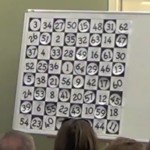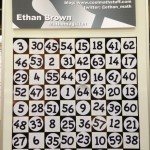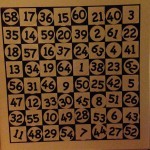(Submitted by Skepticality listener and friend of the blog Christopher Brown.
Hi all:
My son, Ethan Brown performs a Mental Mathematics stage show. A few months ago, he developed a new piece for his act. It’s a version of an old presentation puzzle known as The Knight’s Tour.
Traditionally, performers have allowed audience volunteers to select a square on a Chessboard. The performer then begins on that square and theoretically moves a knight around the board using only legal knight moves (which are “L” shaped). The goal is to land on every single square on the board without landing on any square twice.
Ethan adds an additional twist to this trick by allowing the audience to also select the final square on which the knight must land, finishing the puzzle.
Since debuting this new trick, he has had a chance to perform it 5 times. 3 out of those five times, the two audience members selected the exact same two squares (only they were reversed in one of those times). Our back of the envelope calculations place the Mathematical odds at 1 in 107,374,182, though I suspect something else might be going on here. We have video of 2 of the performances if you’d like to see it. Could there be something psychological that causes people to gravitate to these squares much like people often pick “Ace of Spades” when asked to randomly think of a card?
I have attached photos of the three final Knight’s Tours. Note where the numbers 1 and 64 are.
Thanks! Let me know if you have any questions at all.
Below are the extended notes provided by cognitive psychologist and statistician Barbara Drescher for use in Skepticality Episode 244. Take a look and leave your comments below. Also, please be sure to listen to the podcast for our own hilarious commentary. Also, visit Barbara’s blog.
These notes are a bit dense for the podlet, but maybe you can use the story and just skip most of the math.
+++++
First, let’s assume that the choice of square is completely random in all cases.
We are not particularly interested in the odds that the audience would choose those squares because it’s not the squares themselves that are interesting. It’s the fact that the audience chose the same squares the second time Ethan performed the trick. Therefore, we are given the squares by the first audience and we want to calculate the probability that the second audience would choose those particular squares.
To calculate the odds of choosing those particular squares, we must first note the odds for each, which are pretty easy. The odds of choosing the first square are 1 in 64, or .015625. The odds of choosing the second square are 1 in 32 (since you are limited to only white squares and all white squares are available), or .03125. The odds of choosing both is:
.015625 x .03125 = .00048828125 or 1 in 2,000
1 in 2,000 is the probability that the audience will choose the same squares on the second round that it did on the first round.
The third instance is a bit different because, although the audience chose the same squares, the starting and ending squares are backwards. The calculation is partially the same, but if we allow either square to be the starting square, we are now asking a different question. We now want to know the probability of choosing that specific black square to start and white square to end, or that particular white square to start and black square to end. So, we start with the probability of each scenario, which we know to be about 1 in 2,000, then double it (it is not possible to choose both, so there is no joint probability to subtract). So, the probability of choosing either the same squares or the same squares in reverse on any subsequent game is about .00098 or about 1 in 1,000.
Since each time Ethan performs this trick, there is about 1 in 1,000 chance that the audience will choose those same squares as start/end points, the probability that it would happen on the 3rd, 4th, or 5th time that he performed it is about 3 in 1,000, or .003.
So, taken as a whole, the probability of the audience repeating the first (exact) choices on the second performance and choosing the same squares on one of the three subsequent performances is about .0000015, or 1.5 in a million. So not quite one in a million…
But that is all assuming that the choices were random. I saw nothing in Ethan’s posture or delivery that would suggest any given square as a starting point. However, we do know that human beings don’t do anything at random. I doubt that anyone has conducted studies to determine which squares someone is likely to choose if they are in this particular situation, but I think it is fairly safe to say that they are at least twice as likely to choose squares in the middle of the board than on the edges. I would be interested to find out if that is true, but let’s assume that number is accurate.
That changes the entire game.
We could simply double the probability of choosing those same squares in the second performance, but that wouldn’t give us the whole picture. Now we have to consider the probability of choosing those squares in the first round, because it is no longer a uniform distribution.
If we consider that someone is twice as likely to choose a square that is not on the edge, the probability of choosing that particular square is now .02, or 1 in 50. Likewise, the probability of choosing an ending square that is not on the edge is about 1 in 25. So the probability of choosing those particular beginning and ending squares is:
.02 x .04 = .008 or 1 in 125.
And now the probability of choosing the same squares, with either as the starting square, is about 2 in 125.
And that makes the probability of this scenario about 1 in 31,250.
But I think it is worth noting that the probability of those two squares being chosen at any given performance is independent of the outcome of other performances. It ranges from 1 in 1,000 to 2 in 125, which isn’t exactly “crazy”. But if it keeps happening, I’m going to think seriously about setting up a betting pool.




